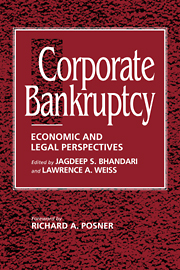Book contents
- Frontmatter
- Contents
- List of tables and figures
- Foreword by the HONORABLE RICHARD A. POSNER
- Preface
- Part I The role of credit
- Part II Bankruptcy as a reflection of the creditors' implicit bargain
- Part III Beyond the basic creditors' bargain
- Part IV Workouts or bargaining in the shadow of bankruptcy
- Part V Alternatives to bankruptcy and the creditors' bargain
- 21 Corporate control and the politics of finance
- 22 The uneasy case for corporate reorganizations
- 23 Bankruptcy and debt: A new model for corporate reorganization
- 24 A new approach to corporate reorganizations
- 25 Debtor's choice: A menu approach to corporate bankruptcy
- 26 Is corporate bankruptcy efficient?
- 27 The voting prohibition in bond workouts
- 28 Financial and political theories of American corporate bankruptcy
- Part VI Experience of other countries
- Index
25 - Debtor's choice: A menu approach to corporate bankruptcy
Published online by Cambridge University Press: 10 December 2009
- Frontmatter
- Contents
- List of tables and figures
- Foreword by the HONORABLE RICHARD A. POSNER
- Preface
- Part I The role of credit
- Part II Bankruptcy as a reflection of the creditors' implicit bargain
- Part III Beyond the basic creditors' bargain
- Part IV Workouts or bargaining in the shadow of bankruptcy
- Part V Alternatives to bankruptcy and the creditors' bargain
- 21 Corporate control and the politics of finance
- 22 The uneasy case for corporate reorganizations
- 23 Bankruptcy and debt: A new model for corporate reorganization
- 24 A new approach to corporate reorganizations
- 25 Debtor's choice: A menu approach to corporate bankruptcy
- 26 Is corporate bankruptcy efficient?
- 27 The voting prohibition in bond workouts
- 28 Financial and political theories of American corporate bankruptcy
- Part VI Experience of other countries
- Index
Summary
Any attempt to justify bankruptcy law from a normative perspective should begin with the observation that bankruptcy law is a term of the contract between the firm and those who extend credit to it. To see why this is so, consider the position of a lender deciding whether to extend credit to the firm and, if so, at what price. The lender will compare the return that it can expect to receive from the firm to the return that it could expect to receive from its best alternate investment. This sets the minimum price that the lender will agree to in order to accept the contract.
The maximum price to which the debtor will agree is set by the debtor's source of alternative funding. The rate of interest which the lender will charge will depend in large part on its assessment of the probability that the firm will be able to repay the loan. The lender will consider the sum of the payments which it expects the firm to make, and discount these payments to present value. If the lender faces no chance of default by the borrower, the interest rate that the lender charges will be relatively low. As the risk of not being paid in full rises, so does the interest rate. Thus we are not surprised when we see healthy companies getting loans at lower rates than more risky companies receive.
- Type
- Chapter
- Information
- Corporate BankruptcyEconomic and Legal Perspectives, pp. 395 - 407Publisher: Cambridge University PressPrint publication year: 1996
- 12
- Cited by



